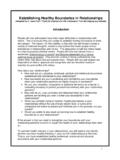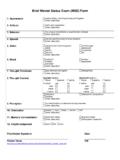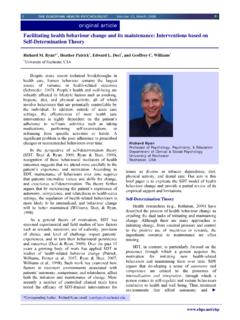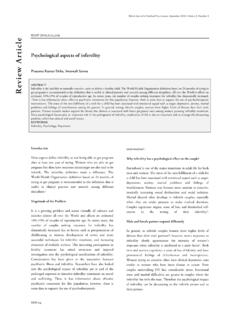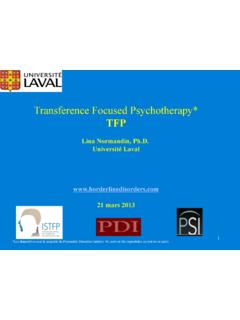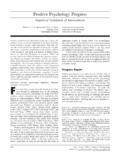Transcription of Gorski-Best Practice Principles - ehcounseling
1 1 Best Practice Principles In The Treatment Of Substance Use Disorders By Terence T. Gorski GORSKI-CENAPS Web Publications ( Copyright, Terence T. Gorski, 2001) ( ; ) May 8, 2001 Terry Gorski and other member of the GORSKI-CENAPS Team are Available To Train & Consult On Areas Related To Best Practice Principles In The Treatment Of Substance use disorders Gorski - CENAPS, 17900 Dixie Hwy, Homewood, IL 60430, 708-799-5000 , This article describes the basic research-based Principles upon which the GORSKI-CENAPS Model of treatment is based. The article is divided into two parts. Part 1: The Nature of Substance Use Disorders: Part one describes the best scientific understanding of the nature of substance use disorders. 1-1. Substance-Related Disorders 1-2.
2 Progressive Symptoms of Substance Dependence 1-3. DSM-IV Progressive symptom Model 1-4. Biopsychosocial Progressive symptom Model 1-5. Characteristics of Substance Use Disorders 1-6. Drug-based Symptoms 1-7. Abstinence-based Symptoms Part 2: Principles Governing Effective Treatment: Part two describes the best scientific understanding of the Principles that govern the effective treatment of substance use disorders. A listing of the references from which these Principles were derived is listed at the end of the article. Part 1: The Nature Of Substance Use Disorders Substance use disorders are primary biopsychosocial conditions that result from the use of mind altering substances by people who have biopsychosocial (physical, psychological and social) risk factors that positively reinforce continued use of mind altering substances and negatively reinforce abstinence.
3 1-1 2 Substance-Related Disorders There are three types of Substance Related Disorders: Substance Abuse Disorders, Substance Dependence Disorders, and Substance-induced Disorders. The Substance-induced Disorders can coexist with either Substance Abuse or Substance Dependence Disorders. (American Psychiatric Association, 1994) 1. Substance Abuse Disorders marked by serious psychosocial problems related to alcohol and drug use that do not meet the criteria of a Substance Dependence Disorder. Abuse Disorders may result from initial experimentation with mind altering substances, involvement in a lifestyle or subculture where alcohol and drug problems are a social norm, or as a consequence of related personality or mental disorders. Patterns of substance abuse may be self-limiting or they may become chronic.
4 The severity of problems associated with substance abuse can vary in response to the seriousness of stress and related life problems. In some cases substance abuse will progress into substance dependence. 2. Substance Dependence Disorders marked by an abnormal biological responses to the ingestion of mind altering substances that results in progressive tolerance and withdrawal that causes a a pattern of compulsive use of the substance to develop which impairs the ability to control substance use and results in the development of substance related life problems. 3. Substance-induced Disorders: There are number of reversible disorders that can be caused by the frequent and heavy use of alcohol and other drugs that common that commonly coexist with substance use disorders.
5 These substance related disorders may be associated with either substance abuse disorders or substance dependence disorders. If these Substance Induced Disorders are not identified and stabilized they can interfere the successful treatment of before both substance abuse and substance dependence disorders. The Substance-induced Disorders are: Intoxication, withdrawal, and Substance-induced Mental Disorders. (1) Intoxication: Intoxication is a reversible set of substance-specific symptoms that are caused by the recent ingestion of alcohol or other drugs. The symptoms consist of significantly maladaptive behaviors caused by impairments in the ability to think clearly, manage feelings and emotions, and self-regulate behavior. Intoxication is often marked by severe impairments in judgment and impulse control.
6 The symptoms persist as long as the blood alcohol or drug level is high enough to cause them. Different substances can cause similar symptoms or interact synergistically to create distortions of the symptoms commonly associated with each drug when used separately. (American Psychiatric Association 1994 pp. 183 - 184) 3 (2) Withdrawal: Withdrawal is a reversible set of substance- specific symptoms that are caused by the cessation or reduction in heavy and prolonged substance use. (American Psychiatric Association 1994 pp. 184 - 187; NIAAA 1989) (3) Substance-induced Mental Disorders: Substance-induced Mental Disorders are symptoms caused by the long term effects of frequent and heavy use of alcohol or other drugs. These effects cause impairments to the brain & nervous system; impaired cognitive & affective functioning; or problems with behavioral control and regulation.
7 The symptoms may be related to intoxication, acute withdrawal, post acute withdrawal (PAW), or long-term brain dysfunction caused by alcohol or drug use. PAW and long-term brain dysfunction are described as Substance-induced Persisting Disorders in DSM-IV. (American Psychiatric Association 1994 pp. 192 - 195) The primary Substance-induced Mental Disorders are: Substance-induced Delirium: Perceptual problems that include: difficulty maintaining environmental awareness; difficulty focusing and sustaining attention on a task or object; difficulty shifting attention from one central focus to another; difficulty maintaining orientation tom person, place, time and context; and problems understanding and communicating ideas verbally and in writing.
8 The symptoms are caused by the effects of substance use that extends beyond the period of intoxication and acute withdrawal. There are two common types of Substance-induced Delirium - Intoxication Delirium and Withdrawal Delirium. (American Psychiatric Association 1994 pp. 127 - 129) If not properly treated, mild to moderate symptoms of Substance- induced Withdrawal Delirium may persist for as long a 60 to 180 days following the cessation of substance use and become worse during periods of high stress. Substance-induced Persisting Dementia: Cognitive impairments including: memory impairments involving the impaired ability to recall previously learned information and/or learn and retain new information (American Psychiatric Association 1994 pp.)
9 152 - 155; NIAAA 1989b). The most common substance-induced cognitive impairments are: Disturbances In Executive Functioning that make it difficult to plan, organize, sequence, abstract central organizing Principles , apply past experience to current situations, and project logical consequences of current behavior into the future. Language Disturbances (aphasia) that make it difficult to comprehend what is read and and understand complex or abstract 4 verbal communication. Motor Function Impairments (apraxia) resulting in problems with hand-eye and psychomotor coordination which often manifests in clumsiness, slowed reflexes, and mild disturbances in balance and gait. Sensory Recognition Impairments (agnosia) that make it difficult to immediately recognize familiar objects by touching, hearing, or seeing them.
10 Substance-induced Persisting Amnestic Disorder: Memory impairments that make it difficult to learn & recall new information, recall previously learned information, or recall past events. The memory impairments cause problems with interpersonal relationships, occupational functioning, or the performance of routine acts of daily living. (American Psychiatric Association 1994 pp. 161 - 162) Substance-induced Psychotic Disorder: Difficulty maintaining orientation to person, place, time, and context caused predominately by hallucinations and delusions. (American Psychiatric Association 1994 pp. 310 - 315) Hallucinations can occur in any sensory modality causing people to see things that aren't there such as poorly formed shapes or shadows to detailed objects and persons (visual hallucinations); hear things such as annoying poorly formed sounds to specific words and statements (auditory hallucinations); feel things such as bugs crawling on them (tactile hallucinations); smell things that aren't there (olfactory hallucinations), taste things that aren't there (gustatory hallucinations); Delusions: Delusions are strongly held beliefs not supported by evidence and not affected by the presentation of evidence that demonstrates they are not true.
